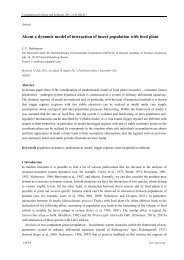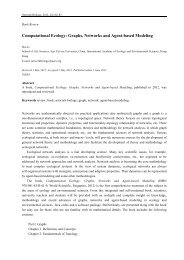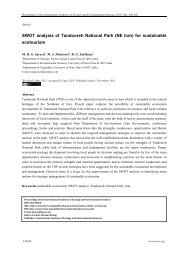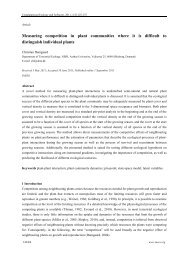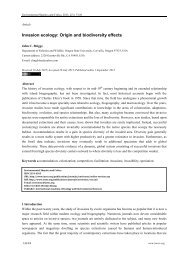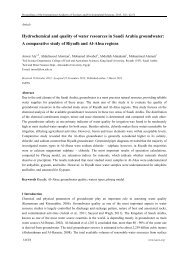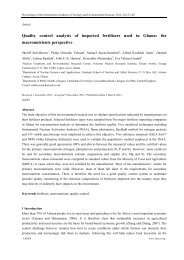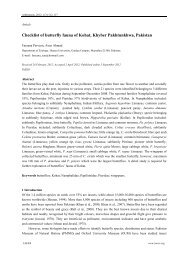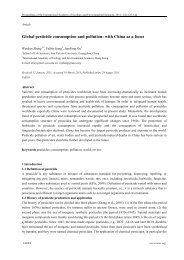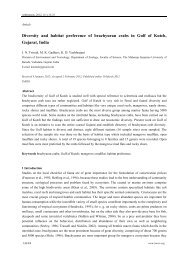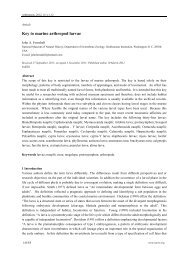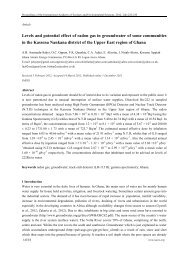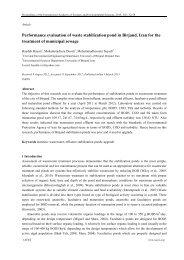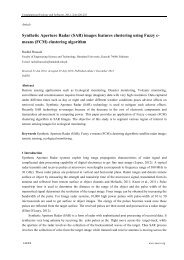Impact of tall buildings in environmental pollution
Impact of tall buildings in environmental pollution
Impact of tall buildings in environmental pollution
You also want an ePaper? Increase the reach of your titles
YUMPU automatically turns print PDFs into web optimized ePapers that Google loves.
Environmental Skeptics and Critics, 2012, 1(1):8-11<br />
9<br />
2 Air Pollution Around Tall Build<strong>in</strong>g<br />
Regard<strong>in</strong>g to the importance roles <strong>of</strong> <strong>build<strong>in</strong>gs</strong> <strong>in</strong> <strong>environmental</strong> <strong>pollution</strong> particular air <strong>pollution</strong>, Abbaspour<br />
and Behjo (2000) studied on distribution <strong>of</strong> Particulate Matter (PM) and CO concentrations besides the<br />
build<strong>in</strong>g and also <strong>in</strong> different heights <strong>of</strong> build<strong>in</strong>g. Their research was conducted <strong>in</strong> a build<strong>in</strong>g with 27 floors.<br />
The results showed the identification and evaluation <strong>of</strong> <strong>pollution</strong> distributed around the build<strong>in</strong>g will help to<br />
design eng<strong>in</strong>eers choos<strong>in</strong>g the best position <strong>of</strong> w<strong>in</strong>dows regard<strong>in</strong>g to m<strong>in</strong>imal contact with polluted air. It also<br />
revealed that the average concentration <strong>of</strong> CO was <strong>in</strong>creas<strong>in</strong>g from the lowest po<strong>in</strong>t <strong>of</strong> the build<strong>in</strong>g up to about<br />
6-9 floor then with irregular process gradually decreases. It may be due to higher w<strong>in</strong>d speed <strong>in</strong> the upper<br />
edges <strong>of</strong> the build<strong>in</strong>g which causes decreas<strong>in</strong>g the <strong>in</strong>tensity <strong>of</strong> <strong>pollution</strong>. However the <strong>in</strong>creas<strong>in</strong>g height from<br />
the ground is caused <strong>in</strong>creased distance from the primary <strong>pollution</strong> sources (cars) but the volume <strong>of</strong> <strong>pollution</strong><br />
is not associated with the distance from <strong>pollution</strong> sources. It may be due to some factors such as local w<strong>in</strong>ds<br />
and eddy currents around the build<strong>in</strong>g, caus<strong>in</strong>g accumulation <strong>of</strong> <strong>pollution</strong> and scatter them <strong>in</strong> some parts <strong>of</strong> the<br />
build<strong>in</strong>g, therefore, the air flow around the <strong>build<strong>in</strong>gs</strong> which is affected by many factors such as local streams,<br />
location and type <strong>of</strong> <strong>in</strong>s<strong>tall</strong>ation <strong>of</strong> w<strong>in</strong>dows is more important than <strong>pollution</strong> sources for distribution <strong>of</strong><br />
<strong>pollution</strong> parameters (Abbaspour and Behjo, 2000).<br />
3 Role <strong>of</strong> Build<strong>in</strong>gs <strong>in</strong> Climate<br />
Tall <strong>build<strong>in</strong>gs</strong> have a special impact and play an important role on climate or weather and environment which<br />
chang<strong>in</strong>g climate factors are mostly related to sunsh<strong>in</strong>e and w<strong>in</strong>d.<br />
3.1 Sunsh<strong>in</strong>e<br />
Sets high and dense <strong>build<strong>in</strong>gs</strong> to benefit from sun exposure are more restricted, because the shadows on their<br />
adjo<strong>in</strong><strong>in</strong>g <strong>build<strong>in</strong>gs</strong> as lower floors <strong>of</strong> <strong>tall</strong> <strong>build<strong>in</strong>gs</strong> as well as short <strong>build<strong>in</strong>gs</strong> are more <strong>in</strong> the shade.<br />
3.2 W<strong>in</strong>d flaw<br />
Survey <strong>of</strong> w<strong>in</strong>d flow <strong>in</strong> the urban area, especially with<strong>in</strong> <strong>tall</strong> build<strong>in</strong>g <strong>in</strong> two terms is very important:<br />
(1) Tall <strong>build<strong>in</strong>gs</strong> can cause undesirable <strong>in</strong>tensification <strong>of</strong> w<strong>in</strong>d flow <strong>in</strong> urban streets and open spaces<br />
(square).<br />
(2) On the other hand also have the ability to avoid w<strong>in</strong>d flow <strong>in</strong> urban spaces.<br />
In both cases, depend<strong>in</strong>g on various conditions, w<strong>in</strong>d flow or w<strong>in</strong>d stagnation could be favourable or not<br />
favourable. So <strong>in</strong> the polluted urban environments, <strong>in</strong>creased air flow to prevent stagnation and accumulation<br />
<strong>of</strong> the <strong>pollution</strong> is very useful while for pedestrian and visitors <strong>in</strong> open space are undesirable and<br />
uncomfortable.<br />
Generally <strong>build<strong>in</strong>gs</strong> depend<strong>in</strong>g on how their exposure to w<strong>in</strong>d flow, create dual effects <strong>in</strong>clud<strong>in</strong>g w<strong>in</strong>d flow<br />
is <strong>in</strong>creased or recession. Flow rate set po<strong>in</strong>ts with a recession <strong>in</strong> the w<strong>in</strong>d and the <strong>tall</strong> <strong>build<strong>in</strong>gs</strong> can deal with<br />
the accumulation <strong>of</strong> air <strong>pollution</strong> on residents to stop. Also, despite these po<strong>in</strong>ts can reduce the adverse<br />
<strong>environmental</strong> w<strong>in</strong>d flow can be exploited.<br />
If the distance between <strong>build<strong>in</strong>gs</strong> is appropriate, the aerodynamic areas <strong>of</strong> each build<strong>in</strong>g to act <strong>in</strong>dividually<br />
and not <strong>in</strong>terfere <strong>of</strong> w<strong>in</strong>d flow <strong>in</strong> these areas, the impact <strong>of</strong> <strong>tall</strong> build<strong>in</strong>g on w<strong>in</strong>d flow reaches m<strong>in</strong>imum level.<br />
But if the distance between <strong>build<strong>in</strong>gs</strong> is not appropriate the aerodynamic take effect, whatever set is denser and<br />
more compact, the behaviours <strong>of</strong> w<strong>in</strong>d flow and the impact on the speed are required more complex analysis<br />
and apparent negative occurs (Masoud, 1997).<br />
4 Effects <strong>of</strong> Tall Build<strong>in</strong>g <strong>in</strong> Environmental <strong>Impact</strong><br />
Rahbar (2002) reported that the important <strong>of</strong> <strong>environmental</strong> impact assessment on high density build<strong>in</strong>g <strong>in</strong><br />
Tehran. In <strong>environmental</strong> impact assessment and high build<strong>in</strong>g density, consider<strong>in</strong>g the economic issue, social<br />
IAEES<br />
www.iaees.org



